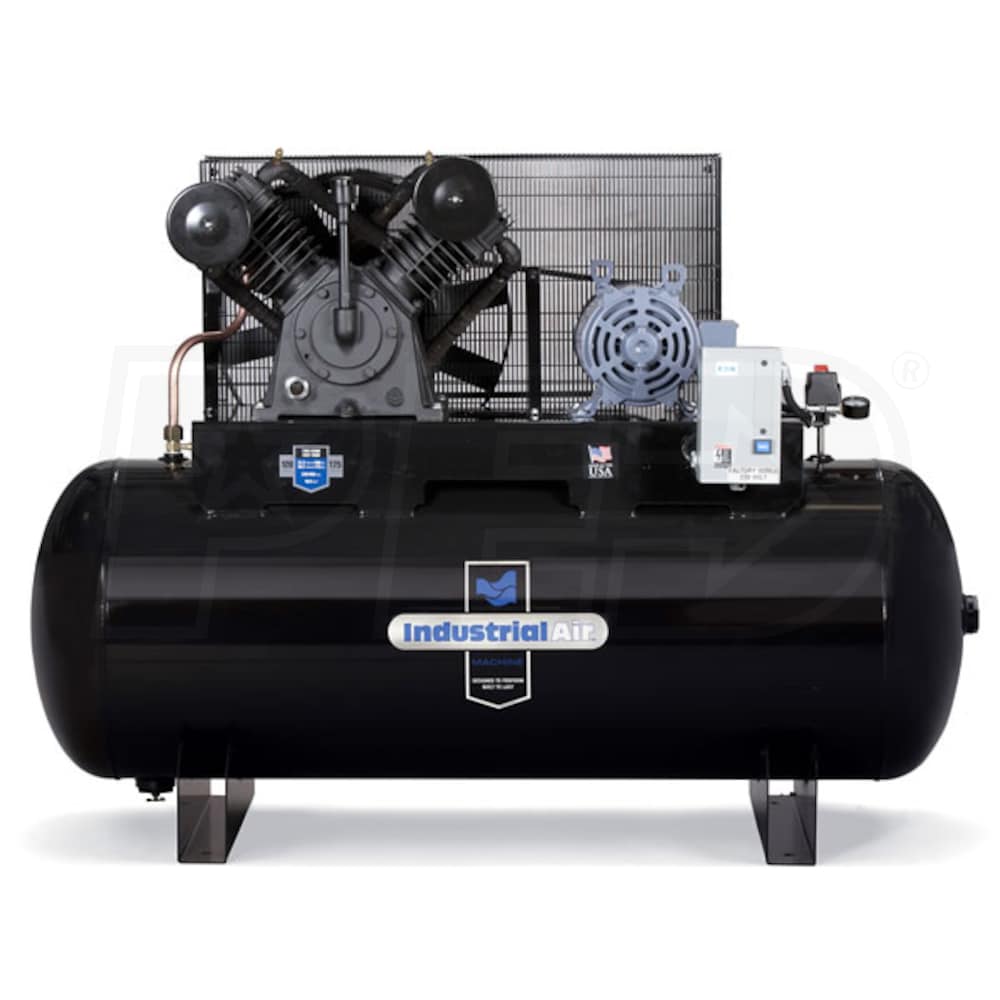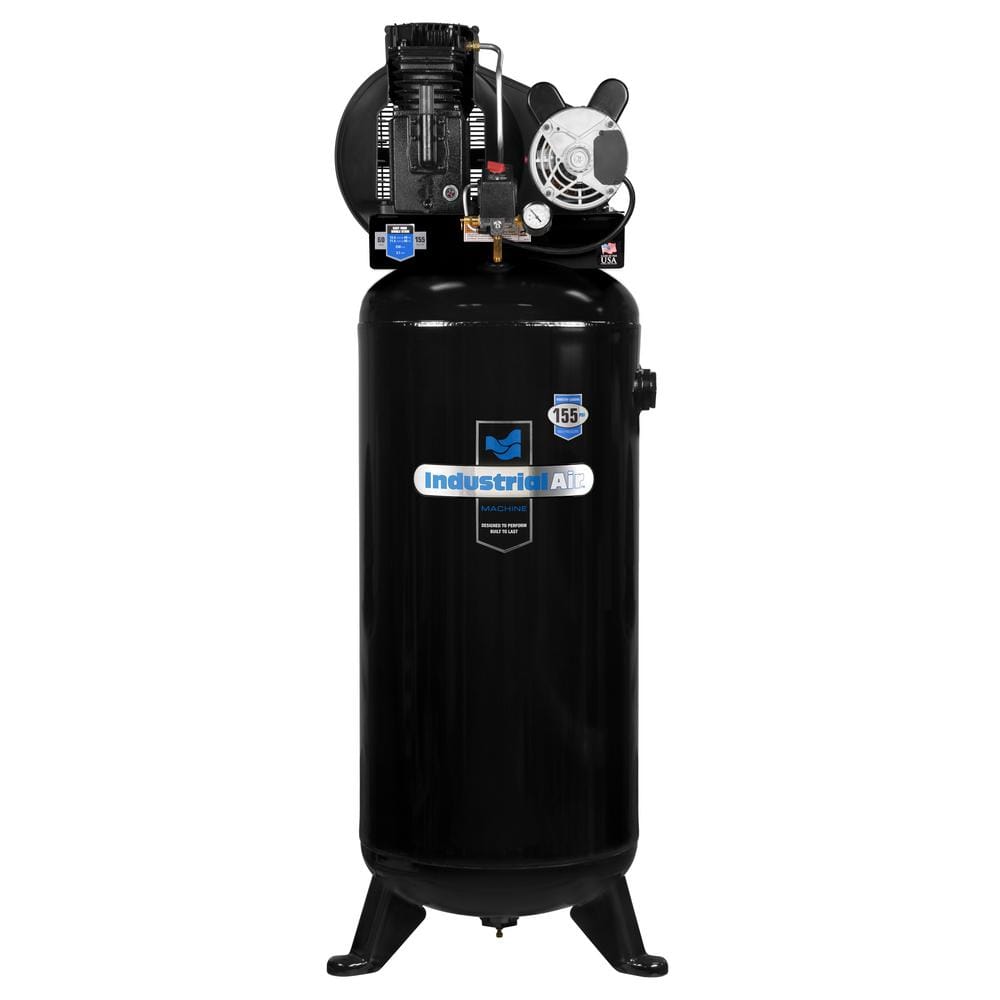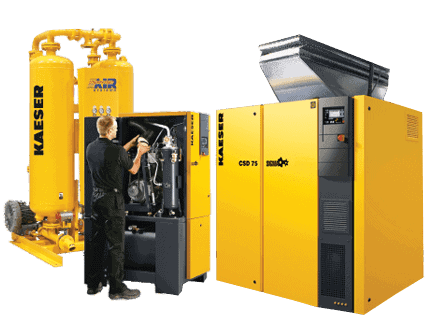An industrial air compressor is a device that converts power into potential energy stored in pressurized air. It is widely used in various industrial applications for powering tools and equipment.
Industrial air compressors play a crucial role in manufacturing and construction sectors. They provide a reliable source of compressed air, essential for operating pneumatic tools, painting, and material handling. Different types of compressors, such as rotary screw and reciprocating models, cater to various needs and applications.
Understanding the specific requirements of your operations helps in selecting the right compressor. Regular maintenance ensures optimal performance and longevity, making these machines indispensable for efficiency. Investing in the right industrial air compressor can lead to significant cost savings and improved productivity in your workplace.

Credit: www.aircompressorsdirect.com
Introduction To Industrial Air Compressors
Industrial air compressors are essential tools in many sectors. They provide compressed air for various applications. Understanding their role can enhance efficiency in operations. This section covers the importance, types, and uses of industrial air compressors.
The Role In Industry
Industrial air compressors serve multiple purposes:
- Powering Tools: They power pneumatic tools like drills and hammers.
- Manufacturing: They assist in processes like painting and packaging.
- Control Systems: They help maintain pressure in control systems.
- Cooling: They provide cooling in specific industrial setups.
Types And Uses
Different types of air compressors cater to various needs. Here are some common types:
| Type | Description | Common Uses |
|---|---|---|
| Reciprocating Compressors | Uses pistons to compress air. | Pneumatic tools, automotive service. |
| Rotary Screw Compressors | Uses two rotors to compress air. | Manufacturing, construction sites. |
| Centrifugal Compressors | Uses a rotating disk to compress air. | Large-scale industrial applications. |
Each type of compressor has specific applications:
- Reciprocating Compressors: Ideal for small-scale tasks.
- Rotary Screw Compressors: Great for continuous operations.
- Centrifugal Compressors: Best for high-demand environments.
Industrial air compressors are vital for efficiency and productivity. Knowing their types and roles helps businesses make informed choices.
Key Performance Metrics
Understanding the key performance metrics of an industrial air compressor is essential. These metrics help ensure optimal performance and efficiency. Businesses can save time and money with accurate measurements.
Measuring Efficiency
Efficiency determines how well an air compressor performs its tasks. Key aspects include:
- Energy Consumption: Lower energy use indicates higher efficiency.
- Operating Costs: Consider costs of electricity and maintenance.
- Output vs. Input: Compare the air produced to the energy consumed.
Use the following formula to measure efficiency:
Efficiency (%) = (Output Air / Input Energy) x 100Understanding Capacity And Pressure
Capacity and pressure are vital for performance. They influence the air compressor’s suitability for tasks.
| Metric | Description |
|---|---|
| Capacity | Measured in cubic feet per minute (CFM). Indicates how much air the compressor can deliver. |
| Pressure | Measured in pounds per square inch (PSI). Indicates the force of the compressed air. |
Consider the following when assessing capacity and pressure:
- Determine the required CFM for your application.
- Check the maximum PSI needed for tools.
Matching these metrics to your needs ensures effective operation.
Factors Affecting Efficiency
Understanding the factors that influence the efficiency of an industrial air compressor is crucial. These factors can significantly impact performance and operational costs. Below are key elements that affect efficiency.
Operating Conditions
Operating conditions play a major role in compressor efficiency. Factors include:
- Temperature: High temperatures can reduce efficiency.
- Humidity: High humidity can lead to condensation.
- Altitude: Higher altitudes can affect air density.
These conditions can create challenges. Proper monitoring and adjustments can help maintain optimal performance. Below is a table outlining how these factors affect performance.
| Factor | Impact on Efficiency |
|---|---|
| Temperature | Higher temps reduce efficiency. |
| Humidity | Causes condensation, affecting output. |
| Altitude | Lower air density reduces performance. |
Maintenance Practices
Regular maintenance is essential for high efficiency. Key practices include:
- Filter Cleaning: Clean filters allow better airflow.
- Oil Changes: Fresh oil reduces friction.
- Leak Checks: Fixing leaks prevents energy loss.
Neglecting maintenance can lead to:
- Decreased efficiency
- Higher energy costs
- Shorter equipment lifespan
Implementing a regular maintenance schedule can enhance performance. Efficiency directly correlates with how well the compressor is maintained.
Selecting The Right Compressor
Choosing the right industrial air compressor is crucial for efficiency. The right choice impacts productivity and costs. Assessing needs and comparing technologies helps in making the best decision.
Assessing Industrial Needs
Understanding your specific requirements is the first step. Consider these factors:
- Air Demand: Calculate the volume of air required.
- Pressure Needs: Determine the required PSI for tasks.
- Duty Cycle: Assess how often the compressor runs.
- Available Space: Check the area for installation.
- Energy Efficiency: Consider operational costs over time.
Collecting this information ensures the compressor meets your needs. A mismatch can lead to high operational costs.
Comparing Technologies
Different compressor types serve various purposes. Here’s a comparison of common technologies:
| Compressor Type | Pros | Cons |
|---|---|---|
| Rotary Screw |
|
|
| Reciprocating |
|
|
| Centrifugal |
|
|
Choosing the right technology can improve operational efficiency. Assess the pros and cons based on your needs.
Optimizing Compressor Settings
Properly optimizing your industrial air compressor settings boosts efficiency. This process saves energy and extends equipment life. Small adjustments can lead to significant improvements.
Adjusting Pressure Settings
Adjusting the pressure settings is crucial for optimal performance. Follow these steps:
- Identify Requirements: Know the pressure needed for your tools.
- Set the Regulator: Adjust the pressure regulator to match requirements.
- Monitor Pressure: Check the pressure gauge regularly.
Maintaining the right pressure reduces wear on the compressor. It improves tool performance too. Use the table below for common pressure settings:
| Tool Type | Recommended Pressure (PSI) |
|---|---|
| Air Nailers | 70 – 100 |
| Spray Guns | 20 – 50 |
| Impact Wrenches | 90 – 120 |
Temperature Control
Temperature control is vital for compressor health. Follow these tips to manage temperature:
- Check Ambient Temperature: Ensure the compressor is in a cool area.
- Inspect Cooling System: Regularly check fans and filters.
- Monitor Fluid Levels: Ensure oil and coolant levels are adequate.
High temperatures can cause overheating. This may damage components. Keeping the compressor cool enhances performance and lifespan.
Regular Maintenance Routines
Regular maintenance routines are crucial for the longevity of your industrial air compressor. These routines help prevent major breakdowns and ensure efficient operation. Proper care saves money and boosts productivity.
Scheduled Inspections
Scheduled inspections keep your air compressor in top shape. Regular checks help identify issues early. Here are key components to inspect:
- Oil Levels: Check daily for optimal performance.
- Air Filters: Clean or replace every month.
- Belts: Inspect for wear and proper tension.
- Electrical Connections: Ensure all connections are secure.
Keep a maintenance log. This log tracks inspections and repairs. It helps identify recurring issues.
Wear And Tear Management
Wear and tear management is vital. It reduces unexpected failures. Here are effective strategies:
- Monitor Operating Hours: Know when to service your compressor.
- Replace Worn Parts: Change parts before they fail.
- Lubricate Moving Parts: Use the right oil to prevent friction.
- Check Vibration Levels: High vibrations indicate problems.
Regularly assessing wear helps maintain efficiency. This practice extends the lifespan of your industrial air compressor.
| Component | Inspection Frequency | Action |
|---|---|---|
| Oil Levels | Daily | Check and refill as needed |
| Air Filters | Monthly | Clean or replace |
| Belts | Quarterly | Inspect and adjust |
| Electrical Connections | Bi-Annually | Tighten and check |
Energy Recovery Systems
Energy Recovery Systems in industrial air compressors help save energy. These systems capture wasted energy and convert it into useful forms. This process reduces operational costs and environmental impact.
Heat Recovery Options
Heat recovery systems utilize waste heat from compressors. This heat can be repurposed for various applications. Here are some common heat recovery options:
- Space Heating: Use waste heat to warm factory spaces.
- Water Heating: Heat water for cleaning or processing.
- Process Heating: Supply heat for manufacturing processes.
Capturing heat improves overall efficiency. It can recover up to 90% of waste heat. This leads to significant energy savings.
Reusing Compressed Air
Reusing compressed air reduces the need for additional energy. Here are effective ways to reuse compressed air:
- Storage Systems: Store compressed air for later use.
- Air Motors: Use compressed air to power tools.
- Dryers: Employ air for drying processes.
Implementing these strategies can lower energy costs. Efficient use of compressed air enhances productivity. Every facility can benefit from reusing this valuable resource.
Monitoring And Control Systems
Monitoring and control systems play a vital role in the efficiency of industrial air compressors. These systems ensure optimal performance and energy savings. They provide real-time data, allowing operators to make informed decisions. With the right tools, companies can enhance productivity and reduce downtime.
Advanced Analytics
Advanced analytics in industrial air compressors offer powerful insights. They help track compressor performance over time. Key benefits include:
- Predictive Maintenance: Anticipate failures before they occur.
- Energy Usage Tracking: Monitor energy consumption for cost savings.
- Performance Benchmarking: Compare against industry standards.
These analytics turn raw data into actionable insights. Users can easily identify trends and anomalies. This leads to better decision-making and improved efficiency.
Automated Control Features
Automated control features enhance the usability of air compressors. They allow for seamless operation with minimal human intervention. Key functionalities include:
- Remote Monitoring: Access data from anywhere.
- Automatic Load Adjustment: Optimize power usage based on demand.
- Real-time Alerts: Receive notifications for issues immediately.
Automation simplifies the management of industrial air compressors. Operators can focus on other tasks while the system handles routine adjustments. This results in reduced operational costs and increased uptime.
Upgrading And Retrofitting
Industrial air compressors are vital for many businesses. Upgrading or retrofitting can enhance performance and efficiency. Understanding when to upgrade and the benefits of retrofitting helps in making informed decisions.
When To Upgrade
Recognizing the right time to upgrade your air compressor is crucial. Consider these signs:
- Increased energy costs
- Frequent breakdowns
- Inability to meet production demands
- Old technology not providing efficiency
Upgrading can provide a significant boost. It ensures reliability and efficiency in operations.
Benefits Of Retrofitting
Retrofitting offers several advantages. Here are some key benefits:
- Cost-Effective: Save on new equipment costs.
- Improved Efficiency: Enhance performance without replacing the entire system.
- Extended Lifespan: Upgrade components for longer service life.
- Reduced Downtime: Minimize interruptions during operations.
Retrofitting can lead to:
| Benefit | Description |
|---|---|
| Energy Savings | Lower energy consumption and costs. |
| Environmental Impact | Reduce carbon footprint with efficient systems. |
| Enhanced Safety | Upgrade safety features to protect workers. |
Retrofitting can transform your existing compressor. It offers a smart way to improve performance.

Credit: www.homedepot.com
Training For Operational Excellence
Training is vital for achieving operational excellence in using industrial air compressors. Proper training boosts efficiency and safety. Skilled operators can manage equipment better. This leads to improved productivity and reduced downtime. Companies benefit from investing in training programs.
Skill Development
Skill development is crucial for effective compressor operation. Training programs should focus on:
- Understanding compressor components
- Learning maintenance procedures
- Mastering troubleshooting techniques
Regular workshops enhance employee skills. This ensures everyone knows the latest technologies. Hands-on training improves confidence and performance. Skilled operators can identify issues early. This prevents costly repairs and downtime.
Best Practices
Implementing best practices ensures smooth compressor operation. Consider these points:
- Perform regular maintenance checks.
- Use the correct lubricants.
- Monitor air quality consistently.
- Keep the work area clean.
- Follow safety protocols strictly.
Documenting procedures helps standardize operations. A clear guide allows quick reference for all employees. This promotes a culture of safety and efficiency.
Future Trends In Air Compressor Technology
The future of air compressor technology is bright. New innovations and sustainable practices emerge regularly. These changes aim to improve efficiency and reduce environmental impact.
Innovations On The Horizon
Many exciting innovations are on the way for air compressors. Here are some key trends:
- Smart Technology: IoT devices will enhance monitoring and control.
- Variable Speed Drives: These will optimize energy use and reduce costs.
- Advanced Materials: Lightweight and durable materials will improve performance.
- Noise Reduction: Quieter models will enhance workplace comfort.
These innovations will make air compressors more efficient and user-friendly. Businesses will benefit from lower operating costs and improved productivity.
Sustainable Practices
Sustainability is crucial in air compressor technology. Companies focus on reducing their carbon footprint. Here are some sustainable practices:
| Practice | Description |
|---|---|
| Energy Recovery Systems | Capture waste heat for other processes. |
| Eco-Friendly Refrigerants | Use less harmful chemicals in cooling systems. |
| Regular Maintenance | Ensure optimal performance and energy efficiency. |
| Renewable Energy Sources | Power compressors with solar or wind energy. |
Implementing these practices reduces waste. It also leads to a cleaner environment. Companies can attract eco-conscious customers by adopting these methods.

Credit: www.compressedairsystems.com
Frequently Asked Questions
What Is An Industrial Air Compressor?
An industrial air compressor is a machine that converts power into potential energy stored in compressed air. This equipment is essential for various applications, including powering tools, inflating tires, and operating machinery. It enhances productivity and efficiency in manufacturing and construction environments.
How Does An Industrial Air Compressor Work?
An industrial air compressor works by drawing in air and compressing it using mechanical force. The compressed air is then stored in a tank for later use. This process allows for a steady supply of air pressure, making it ideal for various industrial applications.
What Are The Types Of Industrial Air Compressors?
There are several types of industrial air compressors, including reciprocating, rotary screw, and centrifugal compressors. Each type has unique features suited for different applications. Choosing the right type depends on factors like required pressure, volume, and intended use.
What Are The Benefits Of Using An Industrial Air Compressor?
Using an industrial air compressor offers numerous benefits, such as increased efficiency and productivity. It provides a reliable power source for various tools and machines. Additionally, it can save time and reduce labor costs by automating repetitive tasks.
Conclusion
Choosing the right industrial air compressor is essential for efficiency and productivity. Assess your specific needs, including pressure and airflow requirements. A quality compressor can enhance performance and reduce operational costs. Investing wisely will ensure your operations run smoothly and effectively.
Make informed decisions to achieve optimal results in your industry.

